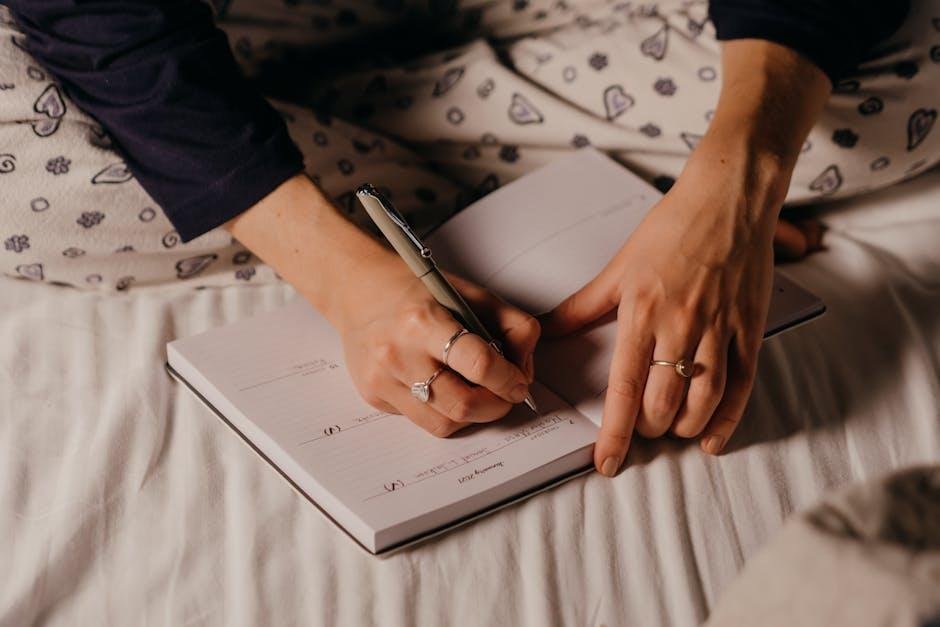As the day’s final moments unfold, our minds often whirl with unfinished tasks, lingering worries, and the anticipation of tomorrow. Yet, amidst this evening flurry, establishing a soothing nighttime routine can be the key to unlocking restful sleep and renewed energy. Crafting such a ritual isn’t about rigid rules or elaborate rituals—it’s a personal journey toward winding down, calming the mind, and signaling to your body that it’s time to rest. In this article, we’ll explore thoughtful tips to help you design a nighttime routine that transforms your evenings into a sanctuary of peace and prepares you for a fresh start each morning.
Table of Contents
- Crafting a Calm and Cozy Environment
- Balancing Screen Time and Mindfulness
- Incorporating Gentle Stretching and Relaxation
- Choosing the Right Foods and Beverages
- Establishing Consistent Sleep Signals
- Personalizing Your Routine for Better Rest
- Q&A
- Insights and Conclusions

Crafting a Calm and Cozy Environment
To foster a tranquil atmosphere that encourages restful sleep, focus on creating a space that appeals to all the senses in subtle, soothing ways. Soft lighting such as warm-toned lamps or dimmable lights can ease the transition from the busyness of the day to relaxation. Incorporating natural elements like wooden accents or indoor plants adds an organic calmness, while plush textures in blankets and cushions invite comfort. Additionally, keeping your space clutter-free is essential; an orderly room promotes mental clarity, making it easier to unwind.
Sound also plays a pivotal role in setting the mood. A gentle white noise machine, or calming sounds like rainfall or soft instrumental music, can mask disruptive noises and create a consistent auditory backdrop. Pay attention to temperature as well—a slightly cool room tends to signal the body it’s time to rest. Here’s a quick guide to ideal environment factors:
| Element | Ideal Setting |
|---|---|
| Lighting | Warm, dimmable, 200-300 lux |
| Sound | White noise or soft nature sounds |
| Temperature | Between 60-67°F (15-19°C) |
| Textures | Soft, breathable fabrics |

Balancing Screen Time and Mindfulness
In the digital age, screens often dominate our evenings, making it challenging to wind down. To foster a peaceful transition into sleep, try setting a strict cutoff time for electronic devices at least an hour before bed. Instead of scrolling mindlessly, engage in activities that promote calmness, such as reading a physical book, journaling, or gentle stretching. This intentional break can recalibrate your mind and allow it to shift from the constant buzz of notifications to a state of restful awareness.
Incorporating mindfulness practices alongside reduced screen exposure amplifies this balance. Here are some simple ways to infuse mindfulness into your nighttime routine:
- Deep Breathing Exercises: Focused breathing can ease tension and increase relaxation.
- Guided Meditation: Use apps or audio recordings to steer your mind into tranquility.
- Gratitude Reflection: Write down or contemplate three positive moments from your day.
| Evening Activity | Benefits |
|---|---|
| Reading a Book | Reduces eye strain and mental stimulation |
| Journaling | Clears thoughts and promotes self-awareness |
| Gentle Yoga | Relieves physical tension and calms the mind |

Incorporating Gentle Stretching and Relaxation
Unwinding your body with gentle stretching can be a transformative step in preparing for sleep. Focusing on slow, deliberate movements helps release tension built up throughout the day, increases circulation, and signals to your nervous system that it’s time to shift into rest mode. Simple stretches like reaching overhead, gentle side bends, or seated spinal twists are perfect for loosening tight muscles without overstimulating your body. Incorporate deep, mindful breaths to amplify the calming effect and encourage a deeper connection between your body and mind.
Pairing this with relaxation techniques enriches your nighttime ritual further. Consider including activities such as progressive muscle relaxation or guided imagery, which actively reduce stress hormones and promote tranquility. Here’s a quick list of easy relaxation methods to try:
- Body scan meditation: Tune into each part of your body, noticing areas of tension and consciously releasing them.
- Breath focus: Practice slow, rhythmic breathing to quiet your mental chatter.
- Aromatherapy: Use calming essential oils like lavender or chamomile to create a peaceful atmosphere.

Choosing the Right Foods and Beverages
Opting for the right snacks and drinks before bed can make a significant difference in how well you sleep. Reach for light, nutrient-rich options like a small bowl of oatmeal, a banana, or a handful of almonds, which can help boost serotonin production and calm your mind. Avoid heavy, spicy, or sugary foods that might cause indigestion or restless sleep.
Hydration matters, but timing is everything. Choose calming beverages such as herbal teas—chamomile, lavender, or peppermint are top picks—that soothe your nerves without keeping you up. Steer clear of caffeine and alcohol, which can disrupt your sleep cycle and leave you feeling groggy the next day. Here’s a quick reference to guide your choices:
| Recommended | To Avoid |
|---|---|
| Almonds | Pizza |
| Bananas | Spicy Chips |
| Chamomile Tea | Coffee |
| Warm Milk | Energy Drinks |

Establishing Consistent Sleep Signals
To gently guide your body into nighttime mode, it’s essential to incorporate habits that send clear, repetitive signals your brain recognizes as bedtime cues. Consistency is key—establishing predictable patterns each evening helps your internal clock adjust and reduces the struggle to fall asleep. Consider winding down with activities that relax the senses, such as dimming the lights, reading a favorite book, or listening to calming music. These cues act like a gentle whisper, telling your body that it’s time to slow down and prepare for rest.
Integrate simple rituals that your body and mind can associate with sleep. Below are a few effective signals you can experiment with:
- Warm herbal tea: A caffeine-free blend signals relaxation.
- Consistent alarm: A soft tone marking bedtime reinforces the routine.
- Screen dimming: Lowering brightness reduces blue light impact.
- Gentle stretching: Loosens muscles and signals closure of the day.
| Signal | Effect | Best Time |
|---|---|---|
| Herbal Tea | Calms nerves | 30-60 mins before bed |
| Dim Lights | Prepares brain for sleep | 1 hour before bed |
| Soft Music | Reduces stress | During wind-down |
| Stretching | Relaxes muscles | 15 mins before bed |

Personalizing Your Routine for Better Rest
Everyone’s sleep needs and preferences are wonderfully unique, which means a one-size-fits-all approach rarely works when crafting the perfect nighttime protocol. Start by observing your natural sleep patterns and pinpoint what activities help you unwind naturally. Some may find solace in reading a book under warm lighting, while others might thrive with light stretching or journaling to clear the mind. Experiment with different calming actions, and notice which ones make you feel most relaxed and ready for bed.
- Adjust room temperature: Cooler environments often promote deeper sleep.
- Customize lighting: Use dim, warm-toned lights to cue your body for rest.
- Personalized wind-down time: Set a consistent time that suits your lifestyle for starting your routine.
- Incorporate soothing sounds: Try white noise, nature sounds, or silence—whichever soothes you best.
| Element | Options to Personalize |
|---|---|
| Lighting | Low amber bulbs, salt lamps, smart dimmers |
| Activities | Reading, meditation, light yoga, aromatherapy |
| Sounds | White noise, ocean waves, calming playlists |
| Sleepwear | Breathable fabrics, weighted blankets, eye masks |
Q&A
Q: Why is having a nighttime routine important?
A: A nighttime routine signals to your body that the day is winding down, helping to reduce stress and prepare your mind for restful sleep. It can boost overall well-being by promoting consistency and relaxation before bedtime.
Q: What are some simple steps to include in a nighttime routine?
A: Start with calming activities like dimming the lights, turning off screens, and perhaps sipping a warm, caffeine-free beverage. Gentle stretches or deep breathing exercises can ease tension. Reading a book or journaling thoughts can also provide a soothing transition from the busyness of the day.
Q: How early should I begin my nighttime routine?
A: Ideally, begin 30 to 60 minutes before you plan to sleep. This timeframe allows your body to gradually slow down and prepare for rest, making it easier to fall asleep when you lie down.
Q: Can technology be part of a nighttime routine?
A: While technology can be stimulating, using it mindfully helps. Consider devices with “night mode” settings to reduce blue light, or use apps designed for relaxation, like guided meditations or calming sounds. However, it is generally best to avoid screens right before bed to reduce alertness.
Q: How can I customize my nighttime routine to suit my lifestyle?
A: Personalize your routine by incorporating activities you enjoy that promote relaxation—whether that’s light reading, skincare rituals, or listening to music. The key is consistency and choosing calming habits that feel natural to you.
Q: What should I avoid during a nighttime routine?
A: Steer clear of stimulating activities like intense exercise, heavy meals, or emotionally charged conversations. Also, avoid caffeine and alcohol close to bedtime, as they can disrupt sleep quality.
Q: How long does it take to see benefits from a nighttime routine?
A: Many people notice improvements in sleep quality and relaxation within a week or two of consistent practice. The more regular the routine, the more effective it becomes in signaling your body to wind down.
Q: What if my routine doesn’t seem to help with sleep issues?
A: If sleep difficulties persist despite a nighttime routine, it may be helpful to consult a healthcare professional. Sometimes underlying conditions or lifestyle factors need addressing in tandem with relaxation habits.
Q: Can a nighttime routine improve mental health?
A: Absolutely. Creating a dedicated wind-down period helps reduce stress and anxiety by providing structure and mindful self-care, fostering a sense of calm that extends beyond bedtime.
Q: What’s one creative tip to make my nighttime routine enjoyable?
A: Try crafting a signature bedtime ritual, like writing a short gratitude list, creating a cozy reading nook with soft lighting, or listening to a favorite calming playlist. Making it a personal ceremony turns the routine into a cherished daily experience.
Insights and Conclusions
As the stars take their places in the night sky, so too can your evening routine find its rhythm. Crafting a nighttime ritual isn’t just about preparation for sleep—it’s a quiet act of self-care, a gentle closing chapter to your day. Whether you choose to unwind with a book, meditate, or simply breathe deeply, these moments invite calm and clarity. Embrace the night as your sanctuary, and let your routine be the lighthouse guiding you toward restful, rejuvenating sleep. After all, the way we end our day shapes the promise of tomorrow.















Leave feedback about this